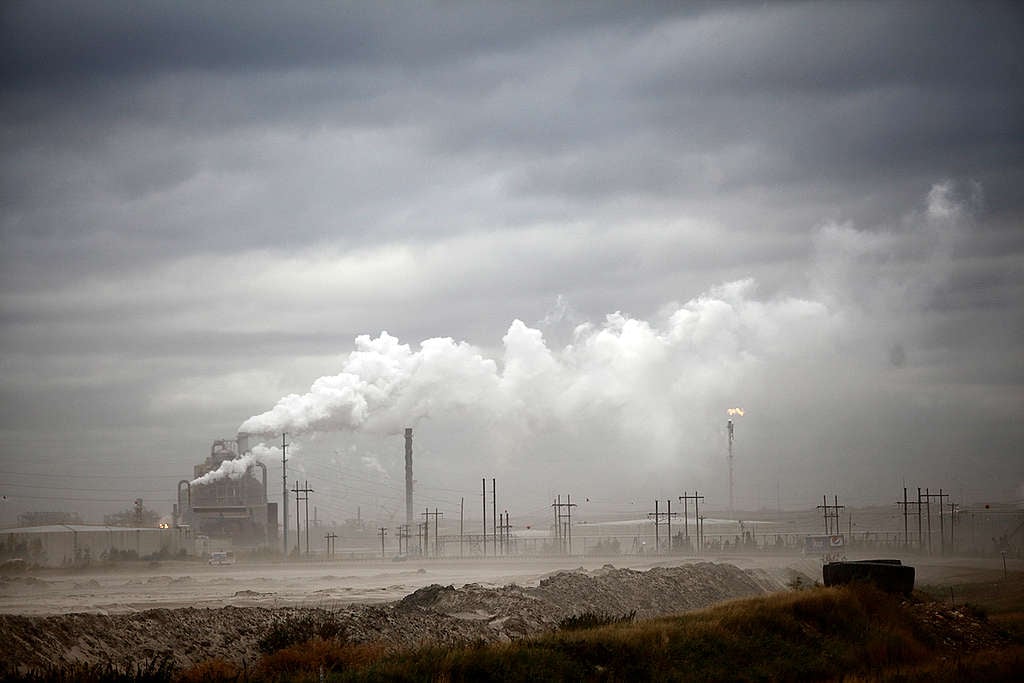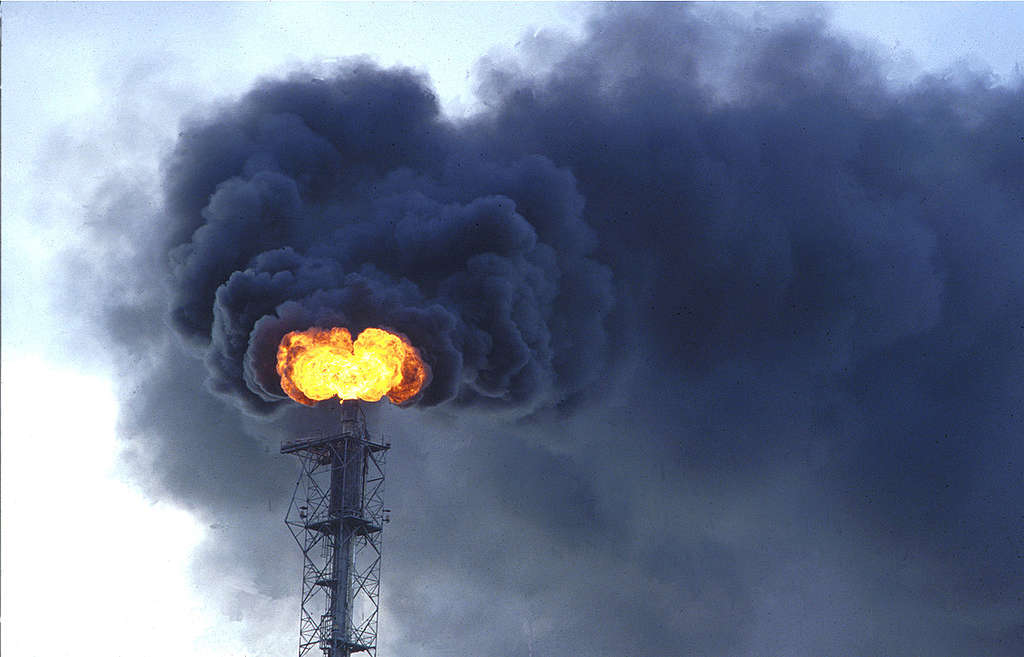Since the oil industry — Shell, Chevron, and others — were not prepared to actually slow oil production to halt global heating, and since they had no intention of aiming for zero carbon emissions, they invented “net zero.” The “net” requires that we subtract some carbon from total emissions to create the illusion of “zero” emissions. Thus, the patriarchs of petroleum profiteering came up with “carbon capture,” a deception that has netted them billions of dollars and euros in public money.
Even the Intergovernmental Panel on Climate Change (IPCC) has enabled the scam, since most IPCC climate models require carbon capture and storage (CCS) to balance the carbon books, always of course, at some time in the distant future.

How the scam works
Oil industry geologists knew in the 1950s that all oil fields would deplete over time, as pressure dropped in rock formations and the oil would no longer flow. They developed certain “enhanced oil recovery” technologies to extend the life of depleted oil fields, by fracking and by pumping carbon dioxide (CO2) into old wells. However, these technologies were expensive and reduced their gargantuan profit margins. Furthermore, by 1965, even the American Petroleum Institute had anticipated the “catastrophic consequences” of carbon dioxide emissions. Thus the Great Carbon Capture Scam was born.
Industry insiders publicly claimed that they could capture and store the dangerous CO2, using public money of course, while secretly planning to use this captured CO2 for enhanced oil recovery, which would create more carbon emissions. It might take decades for the public to figure out that they had been filched.
In 1948, Chevron discovered a promising field in Scurry County, Texas, which showed signs of depletion by 1951. In 1972, they began the world’s first CCS project, using waste carbon dioxide from a gas field 400 kilometers away, near the Mexican border, shipping it north through a pipeline, and using the gas to extend the life of their Scurry field. After using the CO2, they vented the gas, so there was no real climate advantage. However, the technology worked to produce more oil.
Since the companies intended to use captured CO2 for enhanced oil recovery, the technology was then called “Carbon Capture, Use, and Storage,” (CCUS). In 1992, international oil companies held the first CCUS conference in the Netherlands.
In 1998 Chevron, Exxon-Mobil, Shell, and the Australian government began promoting carbon capture and use for the huge Gorgon gas field in Australia that had two public relations problems: It was in a nature reserve and it produced a relatively dirty, climate-wrecking gas with 14% carbon dioxide waste. Since the carbon had to be captured anyway, to meet export regulations, the oil companies lobbied to have Australian citizens pay for it.
Chevron and their partners received a $60-million grant from the Australian government, and in 2003 Chevron claimed that CCUS was “a vital technology to ensure a safe, reliable supply of energy to meet the world’s needs.” Meanwhile, an API promotional campaign confirmed that CCS was primarily used to “enhance oil production.”
In Australia, the companies promised to capture millions of tonnes of carbon, beginning in 2016, but for the first four years they captured none, and in 2019 the Gorgon CCUS project clogged up with sand and had to shut down for repairs.
To date, Gorgon has captured about 30% of its target for “processing emissions,” but this term hides the fact that the companies have only captured about 2% of the target for total emissions. However, the one thing that Chevron did capture and store was 100% of the $60 million in public hand-outs. “Managing greenhouse gas emissions,” Chevron declared, “is an integral part of how Chevron plans and executes its business.”
The corporate strategy appears to be: Socialize costs and privatize profits. However, carbon capture added an additional strategy: Socialize risk. Since carbon emissions would accelerate global heating, and since the hydrogen produced is highly explosive, the companies faced severe liability risks. No problem: In Australia, Chevron and Shell convinced the government, the taxpayers, to accept liability for the hazardous Gorgon project.
The swindle appears simple: Pretend to help solve a problem, while making the problem worse, socialize the costs and liabilities, and privatize the profits. Clever. However, the unscrupulous scheme began to show signs of unravelling.

Red herrings and red flags
In 2006, the German Federal Ministry of the Environment determined that there was “no direct cost advantage for technologies using fossil fuels [i.e. carbon capture] … compared to advanced renewable energy technologies,” and a year later, the Australian Environmental Protection Agency recommended that the Gorgon project should not proceed due to environmental risks.
EnergyWashington Week revealed, as reported by Oil Change International and the US Environmental Protection Agency, that “A power plant equipped with a CCS system … would need roughly 10 to 40% more energy than a plant of equivalent output without CCS.” More energy consumption yields more CO2 emissions, not less. These warnings and recommendations were ignored.
The American Petroleum Institute continued to promote carbon capture, although their own consultant report on “Carbon Dioxide Enhanced Oil Recovery” warned that “the amount of infrastructure necessary to perform geologic storage on a meaningful level is equivalent to the existing worldwide infrastructure associated with current oil and gas production.” To reverse global heating, CCUS would require doubling the world’s petroleum infrastructure, built up over the previous century, a near impossibility with costs running into the trillions. Furthermore, that infrastructure would require massive mining, transport of materials, cement, steel, and carbon-intensive fabrication, yielding more emissions.
In 2007, as these nagging problems surfaced, BP scrapped a £500-million carbon capture scheme in Scotland. In the US, a “clean coal” CCS project in Mississippi, behind schedule and billions over budget, closed, and the Petra Nova CCS plant in Texas—promising to capture 1.6 million tonnes of CO2 annually—missed its targets over three years of operation and shut down in 2020. The Carbon Capture and Sequestration Technologies program at MIT closed due to the technology’s ecological damage and unviable economics in 2016. By the end of 2020, more than 80% of US CCUS projects had failed.
Meanwhile, Western Australia’s Environmental Protection Authority concluded in 2019 that Chevron should be held accountable for venting gas from the Gorgon project and for failing to capture and store the project’s emissions as promised and required.
Quest for dollars
According to a January 2022 study by Global Witness, Shell’s Quest plant in Canada’s tar sands, is emitting more carbon than it is capturing, with the same annual carbon footprint as 1.2 million gas-powered vehicles. Shell’s scheme, one of the biggest boondoggles of carbon capture chicanery, uses the hydrogen produced to refine thick, toxic bitumen into synthetic crude, creating more carbon emissions. The project also emits methane, a much more potent greenhouse gas.
Global Witness found that although Shell’s Quest plant was capturing 4.81-million tonnes of carbon annually (Mt/yr), it was emitting 12.47 Mt/yr in greenhouse gases from on-site and supply chain emissions and from the power required to operate the CCS system. The plant therefore annually is responsible for some 7.66-million tonnes of greenhouse gases, even after the CCUS bookkeeping tricks.
Shell originally promised to capture 90% of emissions, had to admit failure, and changed their target to 65%, but according to the Institute for Energy Economics and Financial Analysis, the Quest plant failed to reach its target every year from 2015 to 2020.
Upon awarding the Quest project a Canadian-dollar $834-million subsidy (US$654-million, €571-million) Canada’s Ministry of Natural Resources Joanna Sivasankaran claimed that CCS was “an important tool on the pathway to reaching Canada’s ambitious climate goals,” to reach “net-zero by 2050.” However, since the Quest project emits more than it captures and increases tar sands production, the dirtiest, most carbon-intensive petroleum product on Earth, these “ambitious climate goals,” remain unattainable and appear preposterous.
Four hundred international scientists, academics, and energy analysts signed a letter to the Canadian government asking that they halt the subsidy scam. “Deploying CCUS at any climate-relevant scale,” they wrote, “carried out within the short timeframe we have to avert climate catastrophe without posing substantial risks to communities on the front lines of the buildout, is a pipe dream.”
The letter warned that CCUS is “not a negative emissions technology,” with billions of taxpayer dollars used to boost oil production. The scientists and scholars warned of the health impacts to local communities, that the tax subsidies would tie Canada to “dependence on dirty tar sands,” and that the project would add some 50 million metric tons CO2 emissions annually by 2035.
According to Lubicon Cree citizen Melina Laboucan-Massimo, the tar sands project yields “elevated rates of cancers, as well as elevated rates of respiratory illnesses … contamination to the water, destruction and complete fragmentation of the Boreal forest.”
According to Reuters, 26 commercial CCS facilities around the world capture about 40 million tonnes of CO2 each year. To put that in perspective, the world emits about 36.4-billion tonnes of CO2 each year.
That means that after 50 years of CCS development; after billions of dollars in subsidies; after all the hype, deceits, tax breaks, and guarantees; the oil industry captures about 0.1% of annual CO2 emissions. The other 99.9 % pollutes the atmosphere and heats Earth. Meanwhile, most of this captured CO2 is used to produce more oil. Since that first CCS project began in 1972, world CO2 emissions have almost tripled from 14.68 to 36.4 billion tonnes per year, not exactly the “net zero” we were promised.
Carbon capture was a scam from the beginning, and remains so today.

Resources and links:
Carbon Capture: Five Decades of False Hope, Hype, and Hot Air,” Andy Rowell and Lorne Stockman, Oil Change International, June 2021.
Shell’s fossil hydrogen plant in Canada emitting more greenhouse gasses than it is capturing: GlobalWitness report: “Hydrogen’s Hidden Emissions,” January 2022; sourcesand methodology: Pembina “Carbon Intensity of Blue Hydrogen;” Shell, Alberta data set; UK Dept. Transport; and Nimblefins Insurance; calculations shown in annex.
“The Western Australian government rules against the oil and gas company over emissions at the Gorgon LNG project, Guardian, 2020.
“Between a rock and a hard place: The science of geosequestration,” Standing Committee on Science and Innovation, House of Representatives, The Parliament of the Commonwealth of Australia, 2007, PDF.
“Chevron’s Gorgon emissions rise after sand clogs $3.1B C02 injection system,” Peter Milne, Boiling Cold, Jan 12, 2021.
American Petroleum Institute: CCS used to “enhance oil production,” Platts Energy Economist, “Carbon Capture and Storage: panacea or an expensive red herring?” November 1, 2006, reported in Oil Change International, June 2021.
“Summary of Carbon Dioxide Enhanced Oil Recovery (CO2EOR) Injection Well Technology,” James P. Meyer PhD, Contek Solutions, Plano, Texas, for the American Petroleum Institute, web archive
Western Australia’s Environmental Protection Authority concluded that Chevron should be held accountable for venting gas from the Gorgon project: “Chevron Faulted for Gorgon Emissions,” September 30, 2019; cited in “Carbon Capture: Five Decades of False Hope, Hype, and Hot Air,” A. Rowell and L. Stockman, Oil Change International, June 2021.
Over 80% of U.S. CCUS projects have failed: “Explaining successful and failed investments in U.S. carbon capture and storage,” Abdulla et al., Environmental Research Letters, 2021; Science IPO.
“Honest Government Ad, Carbon Capture & Storage,” The Juice Media; “Australien Government” Sept 1, 2021:
“A power plant equipped with a CCS system .. would need roughly 10 to 40 % more energy than a plant of equivalent output without CCS.” EnergyWashington Week, “International Panel Finds Carbon Sequestration Has High Price Tag”, October 12, 2005; JSTOR.
“IEEFA: Carbon capture goals miss the mark at SaskPower’s Boundary Dam coal plant,” IEEFA. “The World’s Only Coal Carbon Capture Plant Is Regularly Breaking,” Audrey Carleton, Vice, 2022. SaskPower; has never met this goal (spglobal), as of the end of 2021.
“Are Canada’s carbon capture plans a ‘pipe dream?” John Woodside, National Observer, Canada, January 20, 2022
400 Canadian scientists’letter urges Canadian government to avoid rewarding companies who use carbon capture technology.
“Shell’s Massive Carbon Capture Plant Is Emitting More Than It’s Capturing,” Anya Zoledziowski, Vice, January 2022.
“Comparison of carbon capture and storage with renewable energy technologies regarding structural, economic, and ecological aspects in Germany,” Peter Viebahn, et al., International Journal of Greenhouse Gas Control, April 2007, p.121-133.
“Fossil Fuel Racism: How phasing out oil, gas and coal can protect communities,” Donaghy, T. & Jiang, C., 2021, Greenpeace.
26 commercial CCS facilities globally, capture about 40 million tonnesCO2/year: “Global CCS capacity grew by a third,” Reuters, Dec. 2020.
2021 global CO2 emissions, 36.4-billion tonnes/year: “Global carbon emissions rebound to near pre-pandemic levels,” Andrea Januta, Reuters, Nov. 2021; from University of Exeter study.
Using carbon dioxide for enhanced recovery: “The Scurry Area Canyon Reef Operating Committee (SACROC) unit, Scurry County, Texas,” over a billion barrels of oil produced, Global CCS Institute, 2016. Carbon Capture, Centre for Climate and Energy Solutions, C2ES.
Exxon predicts Greenhouse Effect, CO2 build-up, and global heating: Exxon internal Engineering Report, 1982.
“Peak oil and the low-carbon energy transition: a net-energy perspective,” Delannoya, Murphy, ASPO France, 2021.
“Grand Transitions: How the Modern World Was Made,” Vaclav Smil, amazon.
“Hydrogen: The dumbest & most impossible renewable,” Alice Friedmann, Energy Skeptic, 2019
Energy Mix over time: Our world in Data
Energy Timeline, Alternative Energy
“COP-26: Stopping Climate Change and Other Illusions,” William E. Rees (Professor Emeritus, University of British Columbia), Buildings and Cities, October 2021.
Leaks Show Attempts to Weaken UN Climate Report, Greenpeace Says, Deutsche Welle, Eco Watch, Oct. 21, 2021.
Anderson, K. & Peters, G. (2016) The trouble with negative emissions: science.org
“A Review of the Role of Fossil Fuel Based Carbon Capture and Storage in the Energy System,” Garcia Freites, S. & Jones, C.; Friends of the Earth Scotland, 2020.
______________________________________________
 Rex Weyler was a director of the original Greenpeace Foundation, the editor of the organisation’s first newsletter, and a co-founder of Greenpeace International in 1979. Rex’s column reflects on the roots of activism, environmentalism, and Greenpeace’s past, present, and future. The opinions here are his own. Visit his personal website.
Rex Weyler was a director of the original Greenpeace Foundation, the editor of the organisation’s first newsletter, and a co-founder of Greenpeace International in 1979. Rex’s column reflects on the roots of activism, environmentalism, and Greenpeace’s past, present, and future. The opinions here are his own. Visit his personal website.